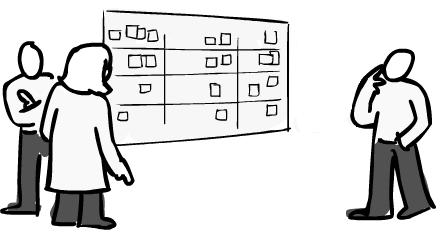As a second post about the first Agile Coach Camp in the Netherlands, end of April 2012, I’d like to tell the story how the Ewan McGregor game was born.
The elephant is in the room
One of the most challenging situations for a team coach or even a team itself, is dealing with an ‘elephant’ in the room. In reality I need to say – avoid dealing with the ‘elephant’ in the room.
What is an elephant in the room, sometimes also known as the pink elephant? In simple words, it’s an obvious situation within a human social structure, nobody wants to talk about and even avoid facing this obvious situation. It’s also a part of teamdynamics. You can read on wikipedia: elephant in the room
I’ve experienced several situations in the past, where there was an elephant in the room – in Teams, in relationships – private and business, even within whole departments or companies. But how do you deal with such situations? Do you confrontate, what can be very hurtful, or do you deal with symptoms? My experience is that you need to be very sensitive when dealing with such crucial topics – and never forget, there is a reason why a problem has reached the level of an elephant in the room!
A background of such situations is based on fear of conflict and a lack of trust – the two most important issues of dysfunctional teams, as well as fear of loosing status. During a coaching session, while reviewing such an ‘elephant in the room’-situation, I had the idea of creating a game where such a situation will be simulated and players need to deal with it. My intention was to create a safe environment which allows players to explore such sensitive situations and learn how to deal with them for the purpose of creating awareness.
I was thinking about different approaches to achieve that game but unfortunately a promising idea was missing. But hey, this is a perfect topic to explore during an open space session and the Agile Coach Camp Netherlands was just a few weeks ahead.
Agile Coach Camp Netherlands – 2012
So, during creation of the OpenSpace marketplace I offered a session for co-creating an interactive game to deal with an elephant in the room. Fortunately approx 10 people showed up for the session – wow, that was much more than I hoped would come.
What happened now, I don’t know how to describe it best, let’s just say – what happened now was just magic!
The game was evolving out of an empirical process of simulating an ‘elephant in the room’ – in the true sense of the word! We created a huge obstacle with chaotic piled chairs in the room and taped a real tight space around this obstacle.
We then simulated some situations where a team of participants had to deal with daily work while they had to move within the tight taped space around the piled chairs. After simulating some real world examples of team-issues we removed all the chairs so that just the taped space was remaining on the floor. We asked the team to repeat all team situations in the room, imagining that the chairs were still in the room.
As an Agile Coach Camp is an OpenSpace unconference, there were Bumblebees and Butterflies dropping in the session room by chance. You might be able to imagine that this must be a funny situation for an observer who does not know what’s happening in that team, where people move within an empty space and make strange movements like a pantomime.
When we asked the newcomers what they observed, they told us that it is strange, it’s obvious that there is something wrong in the team but that they’ve had no idea what’s going on and why the hell the members move so strange within their teamspace . We then invited the newcomers to start coaching the team. What happened next surprised everybody attending that session. Remember – the team members move around an non-existing chaotic pile of chairs!
When asked by an observer what they are doing there was just a simple answer – ‘we are working’. When asked why they move so strange, the outrage of the team about that question became obvious – we don’t move strange, we’re just doing our work as usual. The team members started to defense and became more or less angry about some questions of the observer/coach. Very interesting emotions and a very dangerous situation for the coach emerged. With one single wrong question you can ‘close the door’ for gaining trust of the team. The coach is an ‘outsider’.
What is very interesteing, each time when I facilitated that game, and as far as I know other Facilitators made some similar experiences, almost the same emotions show up, created virtually. Teams start to defense the way they work, even if it’s obvious that there is a problem. Even if it’s just a role play, participants tell that they feel a need for defending themselves, they feel the ‘hot air’ etc.
It was amazing, we created a virtual ‘elephant in the room’ and were able to discover all the emotions which occur also in real situations of this kind.
We then started to concentrate on coaching such a situation and how this uncomfortable experience can be handled. That’s were the real work starts!
When appropriate facilitated and coached, this game can be a great eye-opener for dysfunctional teams and can create new insights, options and opportunities for dealing with crucial issues in teams.
After all
We haven’t published the game-instructions so far. But we asked via the LinkedIn-group ‘Agile Games’ if somebody wants to try out this new game and lots of people did. Several Coaches all over the world have already tried out the Ewan Mcgregor game and gave us some interesting feedback. In addition, I facilitated the game also several times so far. What we’ve found out is, that this game is very helpful and provides a lot of learning experiences and insights in team-dynamics. It’s not just for teams, also for coaches it is an awesome experience to be in the role of a team member and experience the emotions when an ‘outsider’ starts to coach a team on such a crucial topic…
Feedback
If you’re interested in running that game please give me a ping or have a look at the ‘Agile Games’-group on LinkedIn. Beyond that I will publish the game instructions Facilitation Flash Cards.
If you have already tried out the game I’m very curious to read about your experiences – please leave your comment here!
Postscript
A lot of people are asking why ‘Ewan McGregor’ – isn’t that a famous actor?
Yes, that’s true – he is an actor and I need to say that his name has no direct connection to the purpose of the game! During the co-creation session we found out, that when running this simulation with a team which has to deal with such a real ‘elephant’ issue, it might be not a good starting point to introduce a session called ‘the elephant in the room’ – it just could influence the outcome or behaviour of individuals. So we just called it ‘exercise without a name’. And as this naming did not sound appropriate to us, we had the idea to just use a shortcut of it, so we ended up with EWAN. And as somebody called instinctively cool, let’s call it Ewan McGregor… that’s it… =:-)

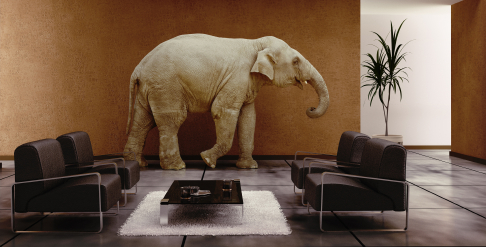
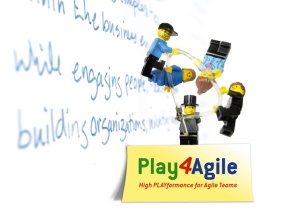
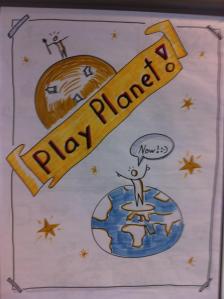
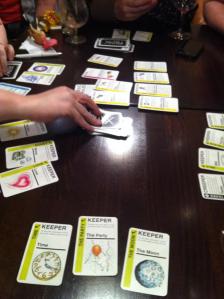
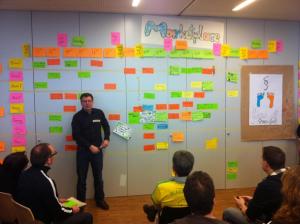

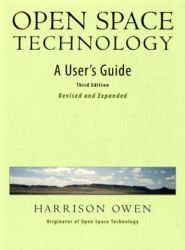
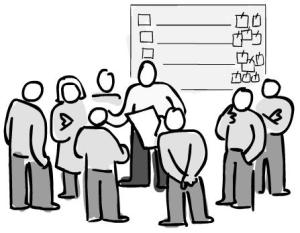 You need to organize space for sessions. These spaces must be equipped with flip charts and whiteboards or panels. In addition you need different Markers, StickyNotes, IndexCards, ball pens and/or felt pens, chairs in a circle and perhaps tables. Depending on the overall topic you need eventually more stuff to organize.
You need to organize space for sessions. These spaces must be equipped with flip charts and whiteboards or panels. In addition you need different Markers, StickyNotes, IndexCards, ball pens and/or felt pens, chairs in a circle and perhaps tables. Depending on the overall topic you need eventually more stuff to organize.
